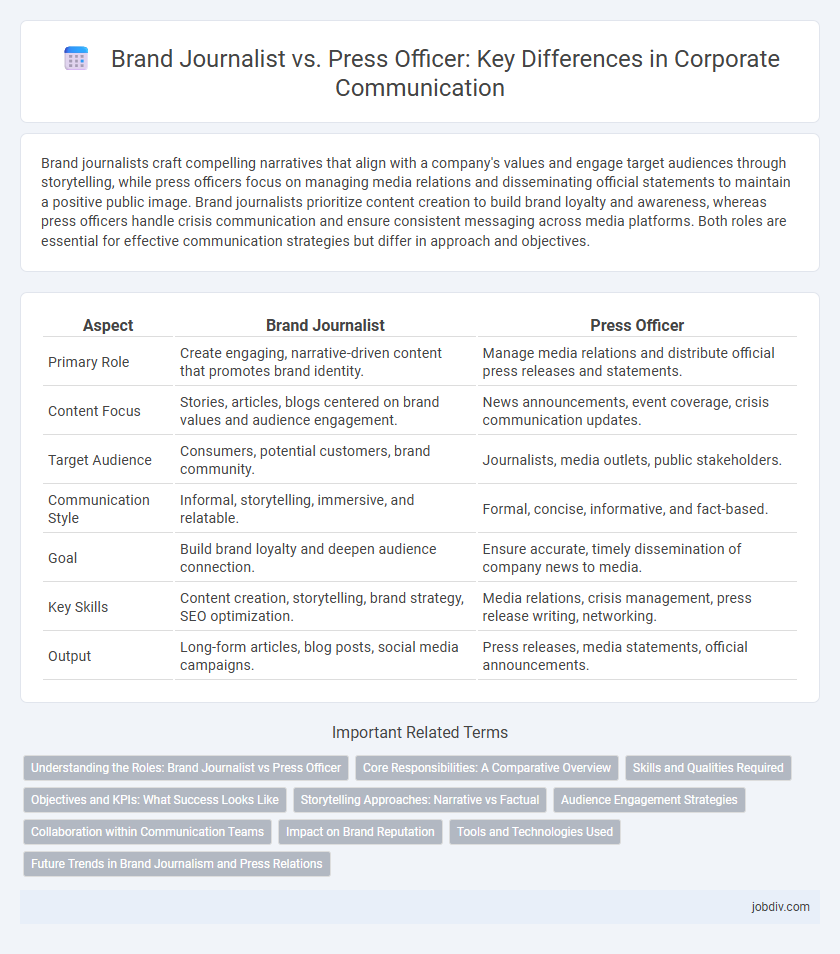Brand journalists craft compelling narratives that align with a company's values and engage target audiences through storytelling, while press officers focus on managing media relations and disseminating official statements to maintain a positive public image. Brand journalists prioritize content creation to build brand loyalty and awareness, whereas press officers handle crisis communication and ensure consistent messaging across media platforms. Both roles are essential for effective communication strategies but differ in approach and objectives.
Table of Comparison
| Aspect | Brand Journalist | Press Officer |
|---|---|---|
| Primary Role | Create engaging, narrative-driven content that promotes brand identity. | Manage media relations and distribute official press releases and statements. |
| Content Focus | Stories, articles, blogs centered on brand values and audience engagement. | News announcements, event coverage, crisis communication updates. |
| Target Audience | Consumers, potential customers, brand community. | Journalists, media outlets, public stakeholders. |
| Communication Style | Informal, storytelling, immersive, and relatable. | Formal, concise, informative, and fact-based. |
| Goal | Build brand loyalty and deepen audience connection. | Ensure accurate, timely dissemination of company news to media. |
| Key Skills | Content creation, storytelling, brand strategy, SEO optimization. | Media relations, crisis management, press release writing, networking. |
| Output | Long-form articles, blog posts, social media campaigns. | Press releases, media statements, official announcements. |
Understanding the Roles: Brand Journalist vs Press Officer
Brand journalists create compelling stories that humanize a company, focusing on long-form content to engage audiences and build brand identity. Press officers manage media relations, crafting press releases and responding to inquiries to maintain the organization's public image and handle crisis communication. Understanding the roles highlights how brand journalists drive narrative development while press officers ensure consistent and accurate media representation.
Core Responsibilities: A Comparative Overview
Brand journalists craft compelling narratives that align with a company's identity, focusing on storytelling that engages target audiences through various media channels. Press officers primarily manage media relations, handling press releases, responding to inquiries, and coordinating public statements to maintain a positive organizational image. Both roles require strong communication skills, but brand journalists prioritize content creation and audience engagement, while press officers emphasize media liaison and reputation management.
Skills and Qualities Required
Brand journalists excel in storytelling, content creation, and audience engagement, demonstrating strong writing skills and a deep understanding of brand voice and market trends. Press officers prioritize media relations, crisis communication, and strategic messaging, requiring excellent interpersonal skills, quick decision-making, and the ability to manage public perception. Both roles demand adaptability, resilience, and a sharp sense of newsworthiness to effectively convey key messages and maintain a positive brand reputation.
Objectives and KPIs: What Success Looks Like
Brand journalists prioritize storytelling that enhances brand reputation and engagement, measuring success through metrics such as content reach, audience interaction, and sentiment analysis. Press officers focus on managing media relations and controlling public narratives, with KPIs centered around media coverage volume, accuracy, and crisis response time. Clear differentiation in objectives ensures targeted strategies, where brand journalists drive brand affinity while press officers maintain consistent public messaging.
Storytelling Approaches: Narrative vs Factual
Brand journalists emphasize immersive storytelling by weaving narrative elements that engage audiences emotionally and build brand loyalty. Press officers prioritize factual reporting, focusing on delivering clear, concise information that ensures media accuracy and trust. The contrasting approaches highlight how brand journalists create compelling stories, while press officers manage information dissemination through precise and objective communication.
Audience Engagement Strategies
Brand journalists craft compelling, story-driven content that resonates emotionally with target audiences, fostering deeper engagement and brand loyalty. Press officers focus on managing media relations and disseminating press releases to control brand messaging and maintain a positive public image. Effective audience engagement strategies blend authentic storytelling with timely, accurate information tailored to the interests and needs of both consumers and media professionals.
Collaboration within Communication Teams
Brand journalists and press officers enhance communication teams by combining storytelling skills with media relations expertise to amplify brand messages. Brand journalists create engaging, narrative-driven content that resonates with target audiences, while press officers manage media interactions and crisis communications to maintain the organization's public image. Collaboration between these roles ensures cohesive messaging, consistent brand voice, and optimized media coverage across multiple platforms.
Impact on Brand Reputation
Brand journalists create compelling, authentic stories that humanize a company and deepen audience trust, significantly enhancing brand reputation. Press officers manage media relations and disseminate information to maintain a consistent public image, which helps protect but may limit the narrative scope. The proactive storytelling approach of brand journalists leads to stronger emotional connections and lasting impact compared to the reactive, message-driven tactics of press officers.
Tools and Technologies Used
Brand journalists leverage content management systems, social media platforms, and multimedia tools like video editing software to craft engaging brand stories that resonate with target audiences. Press officers primarily utilize media monitoring software, press release distribution services, and contact management systems to maintain strong relationships with journalists and coordinate timely communication. Both roles increasingly rely on analytics tools to measure the reach and impact of their communication efforts, optimizing strategies based on data-driven insights.
Future Trends in Brand Journalism and Press Relations
Brand journalists are evolving by integrating multimedia storytelling and data analytics to create authentic, audience-centric content that strengthens brand narratives. Press officers increasingly leverage AI-driven media monitoring and real-time engagement tools to enhance responsiveness and strategic press relations. Future trends emphasize a hybrid approach combining journalistic integrity with proactive press management to boost brand credibility and stakeholder trust.
Brand Journalist vs Press Officer Infographic

 jobdiv.com
jobdiv.com